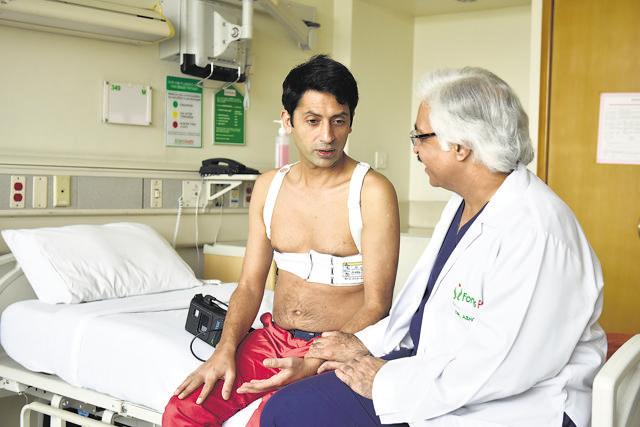Wearable life-savers: Tech for a better health
Among the new-age gadgets you can don for better health are a vest to ward off cardiac arrest, a headband to ease migraines, even a port that administers chemotherapy drugs.
Imagine a vest saving you from cardiac arrest, in just under a minute.

That’s LifeVest, which is typically worn for two months after another attack, when the risk of a second attack is highest. The vest tracks your heart’s rhythm and shocks it back into rhythm if it begins to malfunction.
It’s not the only wearable lifesaver out there. From easing migraines to administering chemotherapy, doctors are using new-age gizmos to help improve patients’ quality of life.
Most are easy to use and require little to no maintenance. The LifeVest, for instance, uses dry, non-adhesive sensing electrodes to monitor the patient’s heart.
“After being treated, when a heart attack survivor is discharged from hospital, he or she runs the risk of a repeat in the first two months. It is a critical phase, in which this device can be helpful,” says Dr Ashok Seth, chairman of cardiac sciences at New Delhi’s Fortis Escorts Heart Institute.

Three of Dr Seth’s patients have already used the vest. None of them has suffered a repeat attack and two of the three have since emerged from the critical phase.
According to Dr Seth, the vest can reduce the risk of having a heart attack by 70% without going to a hospital.
The vest received approval three years ago from the US Food and Drug Administration (FDA) and was introduced in India five months ago.
The vest needs to be worn at all times and taken off only while bathing. Since it is required only for temporary use, it is available on loan at a cost of Rs 50,000 to Rs 75,000 per month.
Read: Superbugs a top global risk
Overall, according to a study by Global Industry Analysts, Inc — a worldwide business strategy and market intelligence source, the global market for wearable medical devices is projected to reach $4.5 billion by 2020.
The chemo port, for instance, delivers drug doses while inserted inside the patient’s body.
A catheter is attached to a disc that’s implanted underneath the skin. The medicine is delivered into the catheter that goes into the vein. The port can cost a minimum of Rs 10,000. Though it can last for months, one needs to flush it with a sterile liquid to ensure the catheter doesn’t get blocked.
“One doesn’t have to stay in the hospital; once the drug is injected into the port, they can go home as it will gradually enter into the vein. It can also be done at home with the help of a trained person, so that the patient gets some psychological relief. There’s also pain relief as repeated needle pricks are avoided,” says Dr PK Julka, professor of radiation oncology at the All India Institute of Medical Sciences, Delhi.
Getting a head-start
A wearable device also came to the rescue for Chennai businessman TN Suresh, 48, who suffered from crippling migraines for four years. “They would happen weekly and completely incapacitate me,” he says.
Then, four months ago, a friend introduced him to Cefaly, a first-of-its-kind device launched in 2014 to relieve migraine pain. Made in the US and approved by the FDA, the headband-like device is battery-run and uses electric current to stimulate nerve endings associated with migraine pain. The device must be worn for 20 minutes a day, and the manufacturers claim a 53% success rate in easing symptoms.
Suresh says his migraines have improved by 80%, both in terms of intensity and frequency. “Being a wearable device, it’s also non-invasive. And it’s a far better option than pain medication,” he says. “This device has been effective for the two Mumbai patients I recommended it to,” says Dr Kaustubh Mahajan, a neurologist at SL Raheja Hospital, Mumbai. “My patients saw the frequency and intensity of their headaches going down by half.”
The Heartmate
The LVAD (or left ventricular assist device), launched in 1966, is an electromechanical circulatory device inserted into the chest cavity to assist failing cardiac function. It is typically powered by a battery pack strapped to the chest, making it a semi-wearable, life-saving device.
“Last year, the Heartmate-II, the fourth generation of LVADs, was introduced in Mumbai,” says Dr Pavan Kumar, consultant and cardiovascular and thoracic surgeon at Mumbai’s Lilavati Hospital. “It uses magnetic technology to lower chances of infection.”
“I haven’t recommended it to many people because of the high cost of an LVAD [ranging from Rs 60 lakh to Rs 1 crore],” adds Dr KR Balakrishnan, cardio-thoracic and transplant surgeon at Fortis Malar, Chennai. “But the three patients who have used it have found it convenient because it’s smaller, less painful and less invasive.”
Catch your daily dose of Fashion, Health, Festivals, Travel, Relationship, Recipe and all the other Latest Lifestyle News on Hindustan Times Website and APPs.



